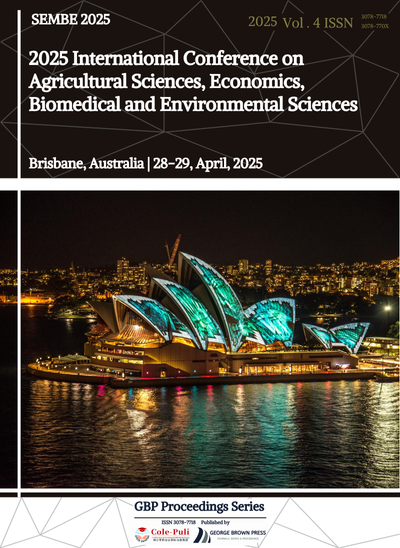Advancements in Research on the Impact of Deficit-Regulated Irrigation on Photosynthetic Characteristics, Yield, and Quality of Drip-Irrigated Potatoes under Film
DOI:
https://doi.org/10.71222/dmw4vj71Keywords:
deficit-regulated irrigation, potato, photosynthetic characteristics, water use efficiency, yieldAbstract
Potato is an essential food and economic crop that contributes significantly to national food security. As the issue of water scarcity in agriculture becomes increasingly prevalent, research into appropriate irrigation systems to accomplish water conservation, high quality, and stable potato yield has attracted widespread attention. The physiological characteristics, growth patterns, and water use efficiency of potatoes at various reproductive stages exhibit distinct responses to deficit irrigation. This paper specifically examines the impact of deficit irrigation on photosynthetic traits, water use efficiency, and potato yield. The findings indicate that severe water deficits hinder the accumulation of photosynthetic products and dry matter in potatoes, ultimately leading to a reduction in yield. In contrast, timely and adequate irrigation promotes optimal growth conditions.
References
1. N. J. Dunstone, D. M. Smith, C. Atkinson, A. Colman, C. Folland, L. Hermanson, S. Ineson, et al., “Will 2024 be the first year that global temperature exceeds 1.5°C?,” Atmos. Sci. Lett., vol. 25, no. 9, p. e1254, 2024, doi: 10.1002/asl.1254.
2. F. Qian, W. Wang, and Y. Liu, “Research into adaptive countermeasures to addressing the effects of climate change on agri-culture,” Chin. J. Popul. Resour. Environ., vol. 12, no. 4, pp. 283–289, 2014, doi: 10.1080/10042857.2014.928984.
3. H. Jiang, G. Wang, S. Li, W. Ullah, S. O. Y. Amankwah, and J. Lu, “Effect of CO₂ concentration on drought assessment in China,” Int. J. Climatol., vol. 42, no. 15, pp. 7465–7482, 2022, doi: 10.1002/joc.7657.
4. H. Cheng, Y. Hu, and J. Zhao, “Meeting China’s water shortage crisis: current practices and challenges,” Environ. Sci. Technol., vol. 43, no. 2, pp. 240–244, 2009, doi: 10.1021/es801934a.
5. Z. Wang, H. Liu, F. Zeng, Y. Yang, D. Xu, Y.-C. Zhao, X. Liu, L. Kaur, G. Liu, and J. Singh, “Potato processing industry in China: Current scenario, future trends and global impact,” Potato Res., vol. 66, no. 2, pp. 543–562, 2023, doi: 10.1007/s11540-022-09588-3.
6. A. N. Furrer, M. Chegeni, and M. G. Ferruzzi, “Impact of potato processing on nutrients, phytochemicals, and human health,” Crit. Rev. Food Sci. Nutr., vol. 58, no. 1, pp. 146–168, 2018, doi: 10.1080/10408398.2016.1139542.
7. O. A. Starovoitova, A. N. Mute, A. A. Manoquina, V. I. Starovoitov, D. A. Makarenkoff, V. I. Nazarov, and H. N. O. Nasibov, “Influence of growing environment on potato tubers quality,” in IOP Conf. Ser.: Earth Environ. Sci., vol. 624, no. 1, p. 012011, 2021, doi: 10.1088/1755-1315/624/1/012011.
8. U. Demirel, “Environmental requirements of potato and abiotic stress factors,” in Potato Production Worldwide, San Diego, CA, USA: Academic Press, 2023, pp. 71–86. ISBN: 9780128229255.
9. X. Mi, G. Feng, Y. Hu, J. Zhang, L. Chen, R. T. Corlett, A. C. Hughes, et al., “The global significance of biodiversity science in China: An overview,” Natl. Sci. Rev., vol. 8, no. 7, p. nwab032, 2021, doi: 10.1093/nsr/nwab032.
10. K. Nouman, M. B. Adnan, A. Tanveer, et al., “Exogenously applied nicotinic acid alleviates drought stress by enhancing morpho-physiological traits and antioxidant defense mechanisms in wheat,” Ecotoxicol. Environ. Saf., vol. 263, p. 115350, 2023, doi: 10.1016/j.ecoenv.2023.115350.
11. F. Li, H. Deng, Y. Wang, X. Li, X. Chen, L. Liu, and H. Zhang, “Potato growth, photosynthesis, yield, and quality response to regulated deficit drip irrigation under film mulching in a cold and arid environment,” Sci. Rep., vol. 11, no. 1, p. 15888, 2021, doi: 10.1038/s41598-021-95340-9.
12. M. A. Badr, W. A. El-Tohamy, S. R. Salman, and N. Gruda, “Yield and water use relationships of potato under different timing and severity of water stress,” Agric. Water Manag., vol. 271, p. 107793, 2022, doi: 10.1016/j.agwat.2022.107793.
13. C. Wagg, S. Hann, Y. Kupriyanovich, and S. Li, “Timing of short period water stress determines potato plant growth, yield and tuber quality,” Agric. Water Manag., vol. 247, p. 106731, 2021, doi: 10.1016/j.agwat.2020.106731.
14. A. Damerum, H. K. Smith, G. J. J. Clarkson, M. J. Truco, R. W. Michelmore, and G. Taylor, “The genetic basis of water‐use effi-ciency and yield in lettuce,” BMC Plant Biol., vol. 21, no. 1, p. 237, 2021, doi: 10.1186/s12870-021-02987-7.
15. Y. Chen, Y.-N. Leng, F.-Y. Zhu, S.-E. Li, T. Song, and J. Zhang, “Water-saving techniques: physiological responses and regula-tory mechanisms of crops,” Adv. Biotechnol., vol. 1, no. 4, p. 3, 2023, doi: 10.1007/s44307-023-00003-7.
16. Y. Niu, K. Zhang, K. S. Khan, S. K. Fudjoe, L. Li, L. Wang, and Z. Luo, “Deficit irrigation as an effective way to increase potato water use efficiency in Northern China: A meta-analysis,” Agronomy, vol. 14, no. 7, p. 1533, 2024, doi: 10.3390/agronomy14071533.
17. A. Jama-Rodzenska, G. Janik, A. Walczak, K. Adamczewska-Sowinska, and J. Sowinski, “Tuber yield and water efficiency of early potato varieties (Solanum tuberosum L.) cultivated under various irrigation levels,” Sci. Rep., vol. 11, no. 1, p. 19121, 2021, doi: 10.1038/s41598-021-97899-9.
18. M. W. Nasir and Z. Toth, “Effect of drought stress on potato production: A review,” Agronomy, vol. 12, no. 3, p. 635, 2022, doi: 10.3390/agronomy12030635.
19. M. A. Mattar, T. K. Zin El-Abedin, H. M. Al-Ghobari, A. A. Alazba, and H. O. Elansary, “Effects of different surface and sub-surface drip irrigation levels on growth traits, tuber yield, and irrigation water use efficiency of potato crop,” Irrig. Sci., vol. 39, pp. 517–533, 2021, doi: 10.1007/s00271-020-00715-x.
20. M. Akkamis and S. Caliskan, “Responses of yield, quality and water use efficiency of potato grown under different drip irri-gation and nitrogen levels,” Sci. Rep., vol. 13, no. 1, p. 9911, 2023, doi: 10.1038/s41598-023-36934-3.











